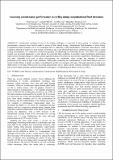| dc.contributor.author | Mannion, Paul | |
| dc.contributor.author | Clifford, Eoghan | |
| dc.contributor.author | Blocken, Bert | |
| dc.contributor.author | Hajdukiewicz, Magdalena | |
| dc.date.accessioned | 2016-12-14T10:19:09Z | |
| dc.date.available | 2016-12-14T10:19:09Z | |
| dc.date.issued | 2016-08-29 | |
| dc.identifier.citation | Mannion, P, Clifford, E, Blocken, B, Hajdukiewicz, M (2016) Assessing aerodynamic performance in cycling using computational fluid dynamics Civil Engineering Research in Ireland Conference (CERI 2016) Galway, Ireland, 29/08/2016- 30/08/2016 | en_IE |
| dc.identifier.uri | http://hdl.handle.net/10379/6237 | |
| dc.description.abstract | Aerodynamic resistance is one of the leading challenges to overcome in elite cycling. To optimize cycling aerodynamics, estimates must first be made by means of wind tunnel testing, computational fluid dynamics or track testing. Computational fluid dynamics (CFD) is an emerging field in analysing cycling aerodynamics. Wind and urban physics create conditions difficult to model in a wind tunnel environment, and while physical track and/or velodrome testing occurs in actual cycling environments, it is difficult to control and quantify all influencing environmental factors. CFD allows for complete control over all model parameters. It also allows for controlled flow conditions to quantify small aerodynamic performance improvements through changes in athlete posture/equipment along with extensive measurement capabilities. Modelling cyclists and other vulnerable road users in urban environments can complement urban designs and strategies to enhance pedestrian/cyclist safety in high wind conditions. Additionally, modelling the aerodynamics of bluff body objects such as a cyclist’s body follows a similar procedure to modelling the airflow over complex structures. This paper presents not only an indepth survey of existing CFD research on cycling aerodynamics and its impact on the cycling community, but also highlights gaps in knowledge regarding cycling aerodynamics and suggests a methodology for future research to follow. | en_IE |
| dc.format | application/pdf | en_IE |
| dc.language.iso | en | en_IE |
| dc.publisher | NUI Galway | en_IE |
| dc.relation.ispartof | Civil Engineering Research in Ireland Conference (CERI 2016) | en |
| dc.rights | Attribution-NonCommercial-NoDerivs 3.0 Ireland | |
| dc.rights.uri | https://creativecommons.org/licenses/by-nc-nd/3.0/ie/ | |
| dc.subject | Civil engineering | en_IE |
| dc.subject | Urban physics | en_IE |
| dc.subject | Aerodynamics | en_IE |
| dc.subject | Computational fluid dynamics | en_IE |
| dc.subject | Wind tunnel | en_IE |
| dc.subject | Cycling | en_IE |
| dc.title | Assessing aerodynamic performance in cycling using computational fluid dynamics | en_IE |
| dc.type | Conference Paper | en_IE |
| dc.date.updated | 2016-12-09T12:40:41Z | |
| dc.identifier.doi | 10.13025/S83S3G | |
| dc.local.publishedsource | http://doi.org/10.13025/S83S3G | |
| dc.description.peer-reviewed | non-peer-reviewed | |
| dc.contributor.funder | |~|1267880|~|1267869|~| | |
| dc.internal.rssid | 11708949 | |
| dc.local.contact | Magdalena Hajdukiewicz, Civil Engineering Eng 1023, Engineering Building, College Of Eng & Informatics, Nui Galway. Email: magdalena.hajdukiewicz@nuigalway.ie | |
| dc.local.copyrightchecked | Yes | |
| dc.local.version | ACCEPTED | |
| nui.item.downloads | 746 | |


